An Exciting of Ancient and Modern Times
Duration: 1 h 30 min – 2 h
Highlights
The most important landmarks – Ancient Forum, Ancient Odeon, Ancient residential building „Еyrene”, Main street, City art Gallery, Dzhumaya Mosque, Roman Ancient Stadium, „Saborna” Street, Cathedral Church „Uspenie na Sveta Bogoroditsa” / The assumption Cathedral Church/, Roman Ancient Theatre, Lamartin house, Church „Sveti Sveti Konstantin and Elena”, Icon Gallery, Hissar Kapiya, Exposition”Bulgarian National Revival”, House of Nikola Nedkovich, Regional Ethnographic museum, Balabanov house, House of Stepan Hindliyan, Bayatova house, Bakalova house, Nebet tepe.
Starting point: Tourist Information Center SQ
Ending point: House of Stepan Hindliyan.
Where to refuel: coffeé shop “Dreams’, pizzeria “Godzila’, pastry shop “Djumaia”, restaurant ‘Piachere”, Armenian restaurant Érevan', restaurant “Ya uzaki’, fast food “Ko shi yam”, Nutrient complex “Centre’, restaurant “Puldin’, Restaurant – gallery “Phillipopolis”, Cultural centre “White house’, Welcome to Plovdiv! You are at the heart of the oldest city in Europe with continuous life. The building in front of you is the Central post office and on the left side is the Central Tourist Information Office. Around and under it is situated the Ancient Forum, dating from the Roman period of the city, the I st c. A.D. The political, economic and social life of the ancient Trimontium (the Roman name of the town) has been focused in this place. The surface area of the forum is of 2 ha and it was unearthed in 1975. The Ancient Odeon takes the northern part of the forum complex. It dates back in the middle of III c. A.D. The Odeon used to be the seat of the city council. The building was a place where many music and literary events have taken place. The Odeon was found in 1988 and was later restored with funds from the Leventis Foundation. To the left of the "Central" square the City Garden Tsar Simeon” is located. It was designed and created following the project of the Swiss Lucien Chevalas, who was known as the court gardener of the Turkish Sultan Abdul Azis at the end of XIX th c. Many interesting monuments, remarkable sculptural compositions, sculptures from more recent times and varied trees and plants may be seen today in the park. The Main street of Plovdiv is superposed on the ancient Roman stadium. The beautiful buildings have their foundations seated on the marble seats of the roman stadium and they exemplify the eclectic architectural style of the end of the XIX and early XX century. They constitute a listed ensemble of monuments of culture. On the left, next to the fountain the building of the Municipality of Plovdiv is situated. It was built between 1911 and1914 and in those times it was the seat of the District police Department. The style of the facade is neoclassical with baroque elements. The next building to the left is the bingo hall "Efbet", which was built in 1925 and until the 90es of last century was a cinema theatre. The remains of a Roman bath were found under it. Turn to the left along the "Star" hotel and continue straight until you reach the subway “Archaeological”. It hosts the Ancient residential building „Еirene”, where you can see the remains of an ancient building, built in the III-IV century A.D. In the representative part of the building premises with multi-coloured floor mosaics were unearthed. According to the legends this house was either a worship place or a public house. In the main street, to the left is bronze sculpture representing Milyo, a picturesque and very popular local character from the past. Several steps from the sculpture is the sign which shows that from this point begins Roman Ancient Stadium. Continuing straight to the north you pass along the commercial centre Excelsior situated in a building from 1911 and designed by the architect Stavrev. The style presents elements of baroque and rococo. Inside, in the basement a part of the original seats of the ancient Roman stadium are displayed. You can go down stairs and visit it. On the other side of the street you see the beautiful building of the City Art Gallery, built in 1881-1882 and designed by Josef Schnitter. The permanent exhibition of the gallery consisting of 230 paintings by renowned Bulgarian artists is presented in eight exposition halls. In about 50 meters along the street you reach the Roman square, an emblematic place for the town. In its centre the northern part of the Roman Ancient Stadium is displayed. The other monument is Dzhumaia mosque. The stadium dates back in II c. A.D., from the time of the reign of Emperor Marcus Aurelius. The Stadium was approximately 240 metres long and 50 metres wide. It could accommodate 30 000 people to watch sports games and competitions similar to the ancient Olympic games. The stadium was restored in 1977.
Dzhumaya Mosque is the main worship place for the Muslims. By 1878 the town had 26 mosques, of which only two exist in the present day. It was built in 1421 -1451 at the place where a Christian church existed dedicated to St. Petka of Turnovo. On the south-western corner of the facade a sun clock donated by a Russian officer was posed in 1878. Continuing up along Saborna street you enter the Old town. To the right where the tic1parking lot is you see the remains of the inner fortress wall of the town.
To the right crowning the staircase you see The assumption Cathedral Church, a 3 nave basilica built in 1844. The struggle for an independent Bulgarian church during the period of the Bulgarian Revival was marked by the first service held in Bulgarian which took place in 1859 in this cathedral. The iconostasis in the church is made of gilded carved wood in style Empire and it has many original icons from the XIX c. Back in the steep street head straight and then turn left. You walk past the building of the Academy of Music, Dance and Fine Arts in Plovdiv and reach the Ancient Theatre built in II c. A.D during the reign of the Emperor Trajan – one of the best preserved in the world. This magnificent archaeological monument is the most remarkable entire public building dating from the ancient times. With seats for about 3 500 spectators, the Ancient Theatre today is the spiritual centre of Plovdiv, where cultural life today mingles with the values of the ancient past. There is a nice panoramic view from the theatre to the southern part of the town and to the beautiful Rhodope mountains.
We leave the Ancient Theatre and continue on the cobbled stone streets of the Old town. We pass along Rhitora House, which is a wonderful Revival period house. Turning to the right and on the right you see the House of Klianti, a national monument of culture since 1846. This asymmetrical house with very fine decoration has been recently restored within an UNESCO funded project.
On the opposite corner the imposing facade of Lamartine house can be seen. It was built by an unknown master in 1829-1830 and is one of the most beautiful symmetrical houses in the Old town. Today the house is run by the Union of Bulgarian writers. In one of its rooms a small museum exhibition displays documents linked with the life of the French poet and politician Alphonse de Lamartine who visited Plovdiv in 1833 and stayed in this house.We continue along “Knyaz Tzeretelev” street and pass by Puldin restaurant, which is the only monument from the medieval times on the territory of the old town. The monastery Mevlevi Hanne was built in XVII c. and was associated with the dancing dervishes. Continue a couple of metres more along the street and then turn to the right along Saborna street. The building to the right on the street is the house of Dr. Stoyan Chomakov /Zlatyu Boyadzhiev Gallery/. It was built in 1858-1860 in neoclassical style. The house is a monument of culture of national importance. Since 1950 until 1980 the department for children literature of the National Library was in this building. At present it hosts the permanent exhibition of over 70 paintings – oil on canvas, of the renowned Plovdiv painter Zlatyu Boyadzhiev.
Further down the street to the right you can visit Icon gallery which is a branch of the town’s Fine Arts Gallery. Founded in 1975, the icon gallery has in its stocks (funds) icons from the middle of the XV to the end of the XIX c, mainly from southern Bulgaria. The building is situated in the yard of the oldest Plovdiv Orthodox Church – the Church St. St. Constantine and Elena on the place of the early Christian basilica. It was restored in 1832 together with the other famous Plovdiv Church St. Nedelya with the special permission of sultan Abdul Azis. The Church St. St. Constantine and Elena is a three-nave basilica measuring 26 to 18 m. The gilt iconostasis of the church was completed in 1836. It presents magnificent baroque carvings with two rows of icons made by famous Renaissance artists. Going out of the church yard you arrive at the small square and you may head in three directions: To the right – through Hissar gate /Hisar kapia/, which is dating back from the Middle Ages. This unique architectural ensemble around the historic eastern gate within the Acropolis fortress wall is one of the symbols of Plovdiv. A gate has existed here since the antiquity. Below the level of the cobblestone street foundations from the roman period (probably from the II century A.D) lie. Part of this ensemble is also the rectangular tower found under the altar of the church St. Constantine and Elena having served for many years as a crypt (ossuary). Further to the south another segment of the fortress is displayed – a round tower dating from the V -VI c., from the time of the Emperor Justinian the Great.
In the small square after Hissar gate, to the left, you see the house of Dimitar Georgiadi. It was built in 1846-1848. The owner of the house, a rich merchant from Plovdiv, has given it as dowry to his daughter Elena, who was married to Dimitar Georgiadi. Today it hosts the exposition of the History Museum – Exposition ”Bulgarian National Revival”, on the theme of the Bulgarian Revival period presenting a rich collection of objects, weapons and photographs.
Next to the History Museum stands the house of the wealthy merchant Nikola Nedkovich. It was built between 1860 and 1863. Entering the yard you see the main house, the building for the servants and a small kiosk facing the street where mainly the women could sit for a cup of coffee and sweets and could gossip watching what was going on in the street. The house impresses with its fine carved ceilings and with its unique collection of furniture and objects, some having belonged to the owner’s family.
Turn right along the path heading back to Hisar Gate and then turn to the right. Up along "Dr Chomakov" street the first house on the right is the house of Argir Kuyumdzhioglu, built in 1847 and known as the Royal house. The building covers an area of 570 square meters and consists of a main residential area and of a service building. The green yard with the marble fountain is very picturesque. It is hidden behind high walls with a small gossiping kiosk at the corner.
Today the house hosts the Regional Ethnographic Museum with a rich collection of costumes, articles of the old crafts, household items, photographs and paintings that give an idea of the traditions, lifestyle and culture during the Revival period. Continue up along Dr. Chomakov str. At number 5a you reach a typical asymmetrical house turned today into a gallery - the Red pony gallery. A few metres further you reach the architectural ensemble of Bayatova and Bakalova houses dating back from the end of the XVIII and early XIX c. They are typical asymmetrical Revival period houses. One of them, Bayatova house is a monument of culture of national significance, while the other – Bakalova house is a monument of local significance. Both houses were restored in 2008 within a project funded by UNESCO/ Japanese Trust Fund.
Further you find yourself atop of the northernmost part of the Old town – Archaeological complex on the hill Nebet Tepe. It is one of the most significant historic sites of Plovdiv with remains from prehistoric to medieval times. Sections of the northern fortress wall of the town from different historic times are preserved. Remains of the ancient fortress walls from Byzantine times can be seen. At the highest point of the hill is situated the ruined citadel that was built by a Thracian tribe in the 3rd century B.C.; there is also a water reservoir, discovered in the south-western slope of Hebet Tepe, which has a volume of 300 000 litres.
Turn right along the path heading back to St. St. Constantine and Elena church and turn down to the right.
In the adjacent open area you can see remains from the roman times and part of the inner fortress wall having served as a foundation for the superposed Revival period houses.
To the right you reach Balabanov house, a landmark of cultural life in Plovdiv. Over the last two decades it was the venue for hundreds of literary events, theatre performances, concerts, exhibitions, meetings and debates with some of the greatest artists of the country. It was built in the early XIX century, was later demolished and in 1979 it was rebuilt following the preserved layouts of the great architect Hristo Peev.
From the yard of Balabanov house through the wicket in the fence using the short cut, you reach the adjacent Hindliyan house. It was built by an unknown master in 1835-1840 following the preferences of the owner's taste. Along the house there are also service premises a bath and a store room in the yard. This is the most richly decorated house in the old town. The Chirpan masters Moka and Mavridi have worked for about six months on the decoration of all rooms and on the exterior consisting of garlands of plants and geometric ornaments, still life and landscape compositions. Leaving Hindliyan house, turn to the left along Artin Gidikov street, from there up the stairs and to the right along Saborna street you reach back the main street of Plovdiv.
Thank you for having visited our town!
We are looking forward to seeing you again soon.




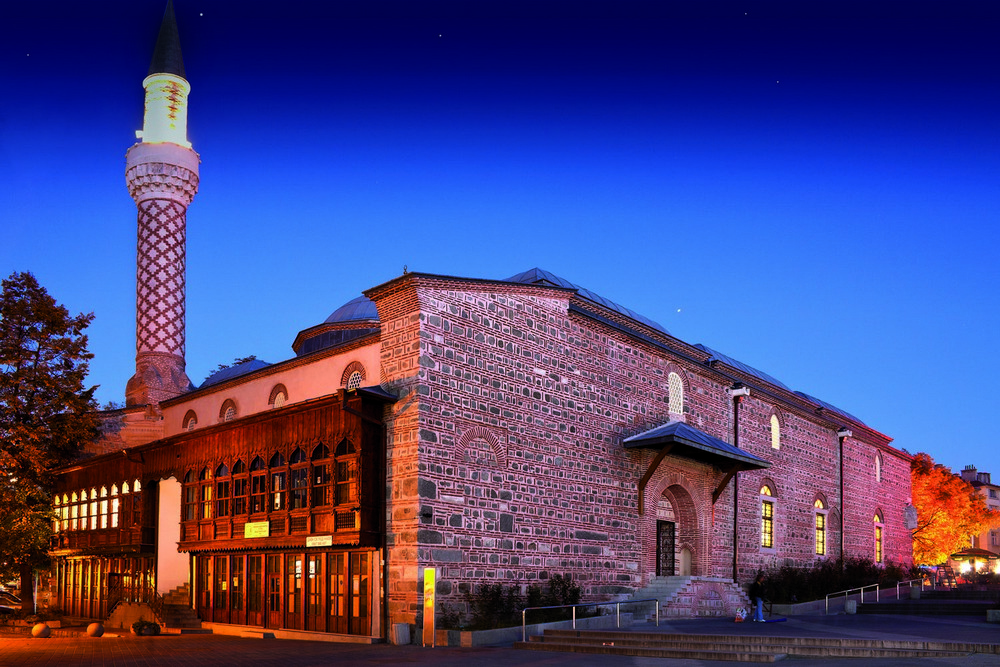

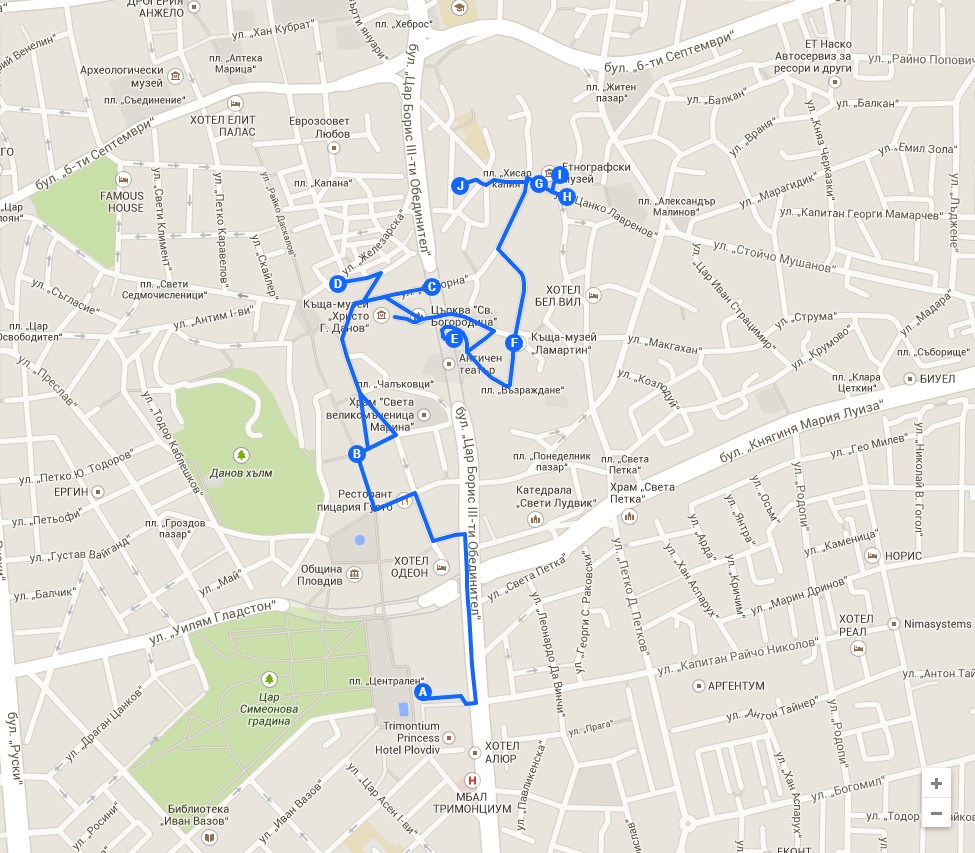




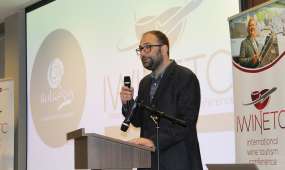
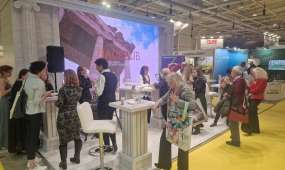
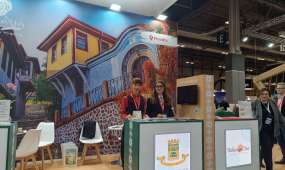
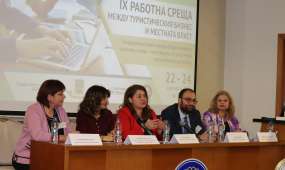

Add new comment